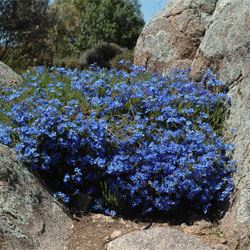Author: Clarence Slocklee Gardening Australia, ABC
Blue is a rare colour in nature, but there are some spectacular blue Aussie flowers that add interest to any garden; Clarence suggests a few.
Blue wildflowers in the bush really stand out – partly because humans have an affinity to blue but also because blue is one of nature’s rarest colours – only 10% of flowering plants have blue flowers and almost none have blue leaves.

Blue is a hard colour to produce. To look blue, plants use red pigments, called anthocyanins, whose appearance is changed by acidity levels to appear red, purple or blue. That’s how you can alter the colour of a hydrangea flower from red to blue by changing the acidity of the soil.
So why bother? Because bees are drawn to blue flowers, so being blue increases a flower’s chance of being pollinated.
Scaevolas or Fan Flowers
Fantastic performers, blooming from spring to autumn, spilling over pots and hanging baskets, or growing as a groundcover in gardens. They don’t need deadheading, they attract bees and butterflies, and have few pests and diseases. They like a sunny spot and good drainage, but can handle dry conditions, light frosts or sea winds. Up to 15-20cm high, they can form wide mats, so give them some space.
Lechenaultias
Famous for their jewel-like, intense colours, and the blue form - Lechenaultia biloba – is a standout. Native to WA, they need a sunny spot with excellent drainage so are best in a container if you’re not on sand. They form a mound to 30cm tall and 30-50cm wide and can be short lived, but are relatively easy to propagate, so try taking cuttings to replace your plant.
Isotoma
Found in well-drained granitic soils across the Eastern states, Isotoma axillaris is tougher than its delicate look suggests. They like full sun and will reward with long-lasting flowers from spring through to autumn.
Dampiera
In the same family as Lechenaultia [Goodeniaceae], dampieras come in a range of colours and forms but most have blue flowers. Dampiera trigona forms a loose mound to 30cm high and is great in containers, or where it can mingle with other plants, forming superb colour combinations. They like sun or light shade, well-drained soil and a warm spot. The bees and butterflies love them.
Dianellas
The strappy flax-lilies nearly all have blue flowers, and many are followed by blue berries, so you get a double dose of blue. ‘Lucia’ is a cultivar of Dianella caerula, which comes from the Latin for ‘dark blue’ so that’s a giveaway about its colour. Growing 30-40cm high and spreading to clumps about 50cm wide, they’re great for nature strips, borders or tough spots because they take sun or part shade and tolerate dry and frost, sand to clay.
Blue was preserved for royalty and gods, but with these plants you can enjoy some heavenly blue in your garden every day.
Original article and video can be found here.

